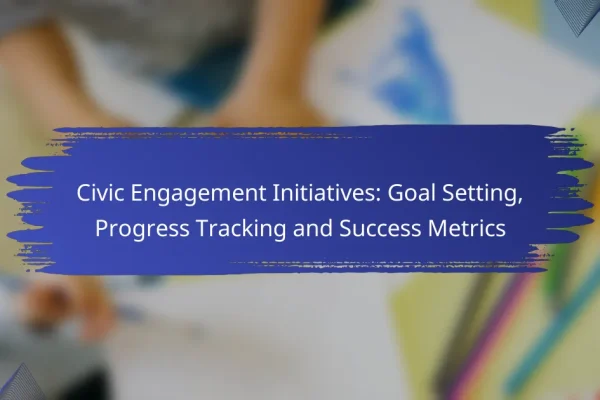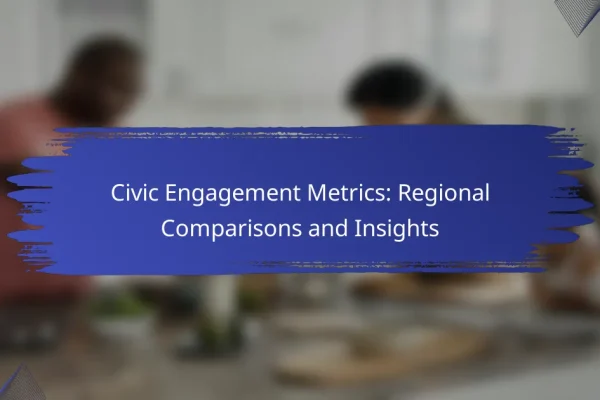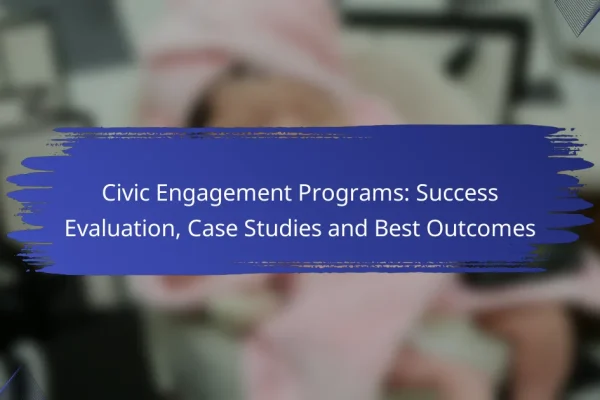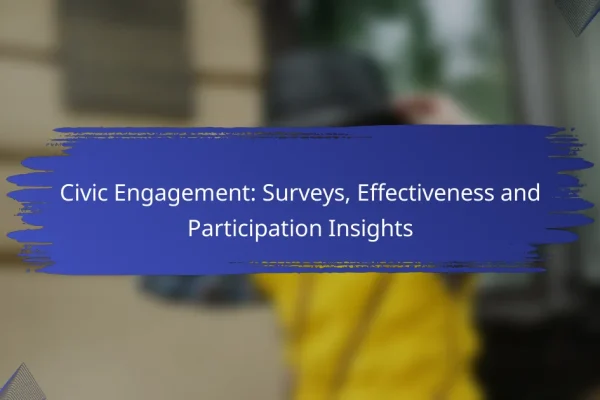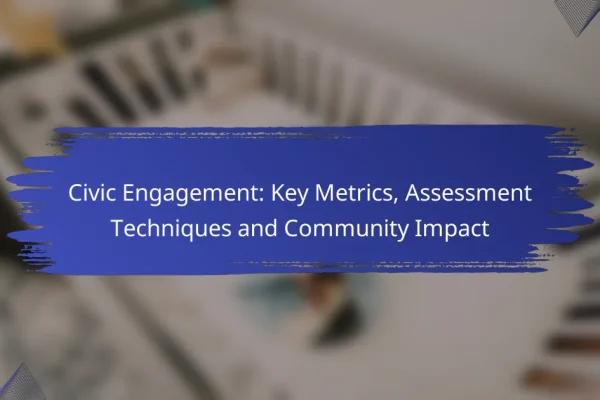How can civic engagement effectiveness be measured in urban areas?
Civic engagement effectiveness in urban areas can be measured through various quantitative and qualitative methods that assess participation and impact. Key indicators include surveys, participation metrics, social media interactions, public meeting attendance, and voting turnout rates.
Surveys and questionnaires
Surveys and questionnaires are vital tools for gauging civic engagement. They can capture residents’ perceptions, motivations, and barriers to participation in civic activities. Effective surveys should include a mix of closed and open-ended questions to gather both quantitative data and qualitative insights.
When designing surveys, consider targeting specific demographics to ensure diverse representation. Online platforms can facilitate distribution, but ensure accessibility for all community members, including those without internet access.
Participation metrics
Participation metrics track the number of individuals involved in civic activities, such as community events, volunteer programs, or local initiatives. These metrics can provide a clear picture of engagement levels over time. For example, measuring attendance at town hall meetings or community clean-up days can highlight trends in civic involvement.
To enhance accuracy, compare participation metrics across different neighborhoods or demographic groups. This can reveal disparities and help tailor engagement strategies to underrepresented areas.
Social media engagement analysis
Social media engagement analysis involves assessing interactions on platforms like Facebook, Twitter, and Instagram to understand civic discourse. Metrics such as likes, shares, comments, and mentions can indicate community interest and involvement in civic issues. Analyzing sentiment in these interactions can also provide insights into public opinion.
Utilize social media analytics tools to track engagement trends over time. This data can inform outreach strategies and help identify key influencers within the community who can amplify civic messages.
Public meeting attendance
Public meeting attendance is a direct measure of civic engagement, reflecting how many residents are willing to participate in discussions about local governance. Tracking attendance at city council meetings, community forums, or planning sessions can reveal levels of interest and involvement in local issues.
Consider implementing strategies to increase attendance, such as offering virtual participation options or providing incentives like refreshments. Analyzing who attends these meetings can also help identify gaps in engagement among different demographic groups.
Voting turnout rates
Voting turnout rates are a critical indicator of civic engagement, showcasing the percentage of eligible voters who participate in elections. High turnout rates often reflect a politically active community, while low rates may indicate disengagement or barriers to participation.
To improve voting turnout, local governments and organizations can conduct outreach campaigns, provide information on voting procedures, and facilitate access to polling places. Analyzing turnout by demographic factors can also help target efforts to increase participation among underrepresented groups.
What tools are available for measuring civic engagement?
Several tools are designed to measure civic engagement effectively, each offering unique features tailored to different community needs. These tools help gather feedback, analyze data, and enhance participation in civic activities.
Polco for community feedback
Polco is a platform that enables local governments to collect feedback from residents through surveys and polls. It allows officials to gauge public opinion on various issues, ensuring that community voices are heard in decision-making processes.
When using Polco, consider crafting clear and concise questions to maximize response rates. Regularly engaging with the community through updates on survey results can also foster trust and encourage future participation.
CitizenLab for engagement platforms
CitizenLab provides a comprehensive engagement platform that facilitates dialogue between citizens and local authorities. It offers tools for idea collection, discussions, and participatory budgeting, allowing communities to collaborate on projects that matter to them.
To effectively use CitizenLab, set clear objectives for each engagement initiative. Promote the platform through social media and community events to reach a broader audience and increase participation.
EngagementHQ for analytics
EngagementHQ is a powerful analytics tool that helps organizations track and measure civic engagement activities. It provides insights into participation rates, demographics, and feedback trends, enabling data-driven decision-making.
When utilizing EngagementHQ, regularly review analytics to identify patterns and areas for improvement. Use this data to tailor future engagement strategies and ensure they align with community interests and needs.
What are the best practices for enhancing civic engagement measurement?
To effectively measure civic engagement, it’s essential to adopt best practices that ensure comprehensive and accurate assessments. These practices focus on utilizing diverse methodologies, analyzing demographic data, and establishing continuous feedback mechanisms.
Utilizing mixed-method approaches
Mixed-method approaches combine quantitative and qualitative data to provide a fuller picture of civic engagement. Surveys can yield numerical insights, while interviews or focus groups can uncover deeper motivations and barriers. This combination allows for a more nuanced understanding of community involvement.
For example, a city might use surveys to measure participation rates in local elections while conducting focus groups to explore why certain demographics are less engaged. This dual approach can highlight specific areas for improvement.
Incorporating demographic analysis
Demographic analysis is crucial for understanding who is participating in civic activities and who is not. By examining factors such as age, income, education, and ethnicity, organizations can identify gaps in engagement. This information helps tailor outreach efforts to underrepresented groups.
For instance, if data shows low participation among young adults, targeted campaigns on social media platforms popular with that demographic can be developed. This ensures resources are allocated effectively to boost engagement where it is lacking.
Continuous feedback loops
Establishing continuous feedback loops allows organizations to adapt and improve their civic engagement strategies over time. Regularly soliciting input from participants can reveal what works and what doesn’t, fostering a culture of responsiveness. This can be achieved through surveys, suggestion boxes, or community meetings.
For example, a local government might implement quarterly surveys to gather feedback on civic programs. By analyzing this data, they can adjust initiatives to better meet community needs, ultimately enhancing overall participation and satisfaction.
What criteria should be considered when evaluating civic engagement?
When evaluating civic engagement, key criteria include inclusivity of diverse populations, alignment with community goals, and the impact on policy changes. These factors help determine the effectiveness and relevance of engagement initiatives in fostering active participation.
Inclusivity of diverse populations
Inclusivity is crucial for effective civic engagement, as it ensures that all voices, particularly from marginalized groups, are represented. Programs should actively seek participation from various demographics, including different ethnicities, ages, and socioeconomic backgrounds.
To assess inclusivity, consider metrics such as the percentage of participants from underrepresented groups compared to the community’s demographics. Engaging with local organizations that serve diverse populations can enhance outreach efforts.
Alignment with community goals
Civic engagement initiatives should align with the specific goals and needs of the community they serve. This alignment ensures that efforts are relevant and can lead to meaningful outcomes that reflect the community’s priorities.
To evaluate alignment, gather input from community members through surveys or focus groups. This feedback can help identify shared objectives and guide the development of engagement strategies that resonate with the community’s aspirations.
Impact on policy changes
The ultimate measure of civic engagement effectiveness is its ability to influence policy changes. Successful initiatives often lead to tangible outcomes, such as new legislation or amendments that address community concerns.
Track the results of engagement efforts by monitoring policy developments following initiatives. Establishing clear goals and timelines can help assess whether civic engagement activities are translating into real-world changes that benefit the community.
How does civic engagement vary across different regions?
Civic engagement can differ significantly across regions due to various factors such as population density, cultural values, and economic conditions. Understanding these variations is crucial for developing effective strategies to enhance participation in civic activities.
Urban vs. rural engagement differences
Urban areas typically exhibit higher levels of civic engagement compared to rural regions. This can be attributed to greater access to resources, organizations, and events that encourage participation, such as town hall meetings and community service opportunities.
In contrast, rural communities may have lower engagement levels due to geographic isolation and fewer available resources. However, rural areas often have strong social ties, which can lead to unique forms of engagement, such as local volunteerism and grassroots initiatives.
Regional cultural influences
Cultural values play a significant role in shaping civic engagement across different regions. For instance, regions with a strong emphasis on community and collectivism may see higher participation in civic activities, while individualistic cultures might prioritize personal interests over community involvement.
Additionally, historical factors and local traditions can influence how communities engage with civic processes. Regions with a history of activism may have more robust civic engagement practices compared to those where such activities have been less common.
Socioeconomic factors
Socioeconomic status significantly impacts civic engagement levels. Individuals from higher-income backgrounds often have more time and resources to participate in civic activities, leading to greater engagement rates in affluent areas.
Conversely, lower-income communities may face barriers such as limited access to transportation or information, which can hinder participation. Addressing these socioeconomic disparities is essential for fostering inclusive civic engagement across all regions.
What emerging trends are shaping civic engagement measurement?
Emerging trends in civic engagement measurement focus on the integration of technology, data analytics, and community-driven approaches. These trends aim to enhance the effectiveness of civic initiatives by providing more accurate insights into community participation and needs.
Increased use of digital platforms
Digital platforms are becoming essential tools for measuring civic engagement. They allow organizations to collect real-time data on participation through surveys, social media interactions, and online forums. This shift enables more dynamic tracking of community sentiments and trends.
For instance, platforms like Facebook and Twitter can be analyzed to gauge public interest in civic issues. Organizations can use analytics tools to measure engagement metrics such as likes, shares, and comments, providing a clearer picture of community involvement.
Data-driven decision making
Data-driven decision making is transforming how civic engagement is assessed and improved. By utilizing data analytics, organizations can identify patterns and correlations in civic participation, leading to more informed strategies. This approach emphasizes the importance of evidence over intuition.
For example, analyzing voter turnout data alongside demographic information can reveal which communities are underrepresented. This insight allows for targeted outreach efforts, ensuring resources are allocated effectively to boost participation.
Community-led initiatives
Community-led initiatives are gaining traction as a way to measure civic engagement. These initiatives empower local residents to take charge of their civic activities, leading to more relevant and impactful engagement strategies. This approach fosters a sense of ownership and accountability among community members.
Programs that involve residents in the planning and execution of civic projects often see higher participation rates. For instance, community forums that solicit input on local issues can lead to increased involvement in decision-making processes.
